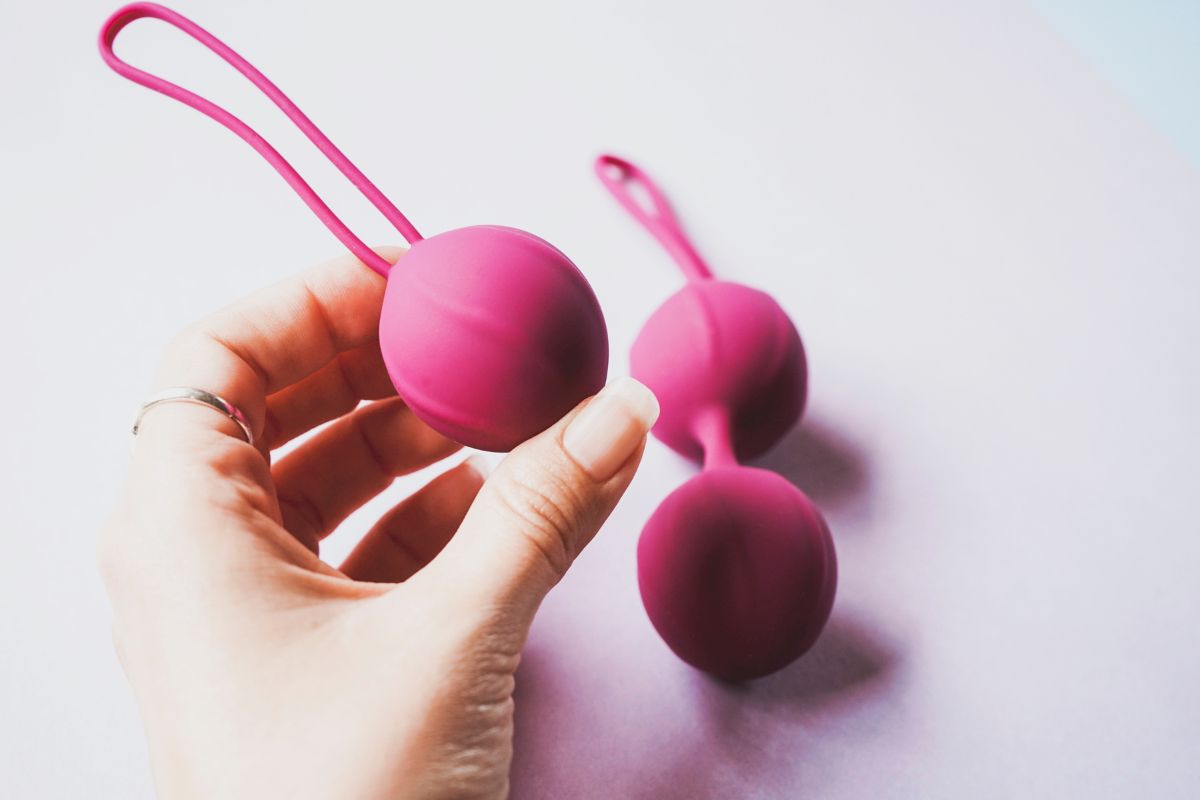Kegel exercises are known for strengthening pelvic floor muscles, and are therefore most popular among women who have given birth or are preparing for childbirth.
These pelvic floor exercises are useful for a variety of issues, including urinary incontinence, pelvic organ prolapse, urge incontinence, and more.

There are a range of kegel exercises available for people of all ages and abilities to practice.
It’s very rare that props are needed for kegel exercises, so they can be completed at home for free.
However, there are far more advantages to kegel exercises than the accessibility and incontinence improvements.
So, if you want to get started with kegel exercises but you’re not sure about how it will benefit you, you’ve come to the right place.
Here are 8 benefits of kegel exercises, suitable for women and anyone with a vagina!
What Are Kegel Exercises?
Kegel exercises are designed to target the pelvic floor muscles.
These muscles surround and support the vagina, uterus, bladder, and rectum. The exercises contract the muscles in an attempt to strengthen them over time.
With persistent use of kegel exercises, women can train their pelvic floor muscles back to how they should be prior to childbirth or weight gain.
This works to prevent bladder leaks, constant need to pee, lower back pain, prolapses, and can even improve sexual intercourse.
Benefits Of Kegel Exercises
1. Kegels Help Recovery From Childbirth
One of the most common reasons why people perform kegel exercises is to help their bodies recover from childbirth.
Childbirth produces an insurmountable amount of stress on the body, whether you gave birth vaginally or by a cesarean.
The area that is arguably most affected by childbirth is the pelvic floor.
After giving birth, the pelvic floor muscles are substantially weaker than before.
This is especially true for vaginal pregnancies, which can actually tear the muscles or even the vagina itself, known as an episiotomy.
As a result, people who have recently given birth typically deal with urinary incontinence and the urge to pee constantly.
Thankfully, the pelvic floor muscles are no different to any other muscles in the body.
This means that they can heal and strengthen with exercises, just as any other muscles will strengthen when going to the gym.
That’s where kegel exercises come in. Fortunately, kegel exercises are fairly easy for new mothers and parents to perform, as they’re not too strenuous.
Plus, the exercises can be completed at home in your spare time, so you don’t have to spend money on going to the gym.
To improve the strength of your pelvic floor muscles, you can start practicing kegel exercises before you give birth, or before you even become pregnant.
This will help your muscles to return to their stronger state once you have given birth.
If you are pregnant, make sure to discuss your exercise goals with your doctor.
While kegel exercises are great for pregnant people, as they don’t contract the uterus itself, you don’t want to push your body if it’s not ready.
2. Kegel Exercises Treat Bladder Leaks
Bladder control issues affect more people than you realize. It’s common for older people, particularly women and those who will experience menopause, to lose control over their bladder.
This is known as urinary incontinence, and can occur as a result of strenuous movements, such as laughing, coughing, sneezing, or lifting heavy objects.
Kegel exercises help to treat bladder leaks because they work to strengthen the pelvic floor muscles, which support the bladder.
Without practicing these exercises, the weak and uncoordinated muscles can’t support the bladder or close the sphincter, resulting in bladder leaks.
3. Kegels Improve Pelvic Health During Menopause
Menopause is a natural period when ovaries stop producing hormones, and menstruation ceases.
While it might sound joyous, there are several downsides to menopause, including weakened pelvic health.
This is because the fluctuating levels of estrogen result in a lack of blood flow to the pelvic floor muscles.
With a lack of blood flow, the muscles decrease in tone, and therefore become weaker.
As a result, it’s common for menopausal women (and premenopausal women) to experience urinary incontinence.
Kegel exercises help to strengthen the pelvic floor muscles, therefore improving the overall pelvic health for those who are menopausal.
4. Kegels Reduce The Risk Of Pelvic Organ Prolapse (POP)
Pelvic organ prolapse, often referred to as POP, is a condition where the vagina is pressed into by one or more pelvic organs.
This is most commonly diagnosed shortly after pregnancy, where the ligaments and pelvic floor muscles have been stretched and weakened.
However, this can also occur after a period of heavy lifting (either for work or at the gym), as well as constipation, obesity, and heavy coughing.
It results in a sensation of pressure in the vagina or pelvis arena. It can also feel like the pelvic organs are close to falling out of the body, a feeling which can worsen in the evening or after vigorous exercise.
Another symptom of POP is dribbling after urination and some incontinence.
Pelvic organ prolapse is often diagnosed by pushing a finger into the vaginal opening and feeling the descended organs.
You can also view the prolapse by using a hand-held mirror to examine the vaginal opening.
POP is caused by the weakening and tearing of the pelvic floor muscles, which is often a result of childbirth, age, or vigorous lifting exercise for prolonged periods.
It is estimated that 50% of women who have given birth will experience a pelvic organ prolapse, as well as 50% of women who are above the age of 50.
It becomes increasingly more common for women who have had multiple births. With each pregnancy, the risk of POP increases.
The same goes for women who had a C-section, especially if they tried to push vaginally before having an emergency cesarean.
Also, if the baby is particularly large, this is another factor that can contribute to a prolapse.
Pelvic organ prolapse isn’t a life-threatening condition, but it can be uncomfortable and potentially painful.
It can also lead to future issues with the bladder and bowel, which can affect the quality of life.
The great news is that kegel exercises can reduce the risk of pelvic organ prolapse significantly by strengthening the pelvic floor muscles.
With stronger muscles comes better support of the pelvic organs, and therefore a lower risk of prolapse.
Even if you experience a prolapse, these exercises will encourage your muscles to get back into action, thus curing the prolapse somewhat completely.
People with POP while doing kegel exercises generally experience fewer symptoms.
5. Kegels Improve Sex
A little known benefit of kegel exercises is that they can improve penetrative vaginal sex for both partners involved.
This is because the exercises make the vagina feel tighter, which can intensify the feeling of an orgasm.
The pelvic floor muscles are responsible for orgasms. They create pleasurable contractions in the genitals, which is a direct result of good blood flow.

Healthy pelvic floor muscles should produce long and intense orgasms. So, if you find having an orgasm an arduous task, it might be because you have weak pelvic floor muscles.
Kegel exercises increase the blood flow to the pelvic floor muscles. This increase of blood circulation also increases lubrication, arousal, and the ability to orgasm at a higher intensity.
It has a secondary benefit, too – a stronger pelvic floor grips onto the partner more tightly during penetrative sex, which is just as pleasurable for the partner!
Kegels are also helpful for anyone who experiences vaginal pain or discomfort during penetrative sex, such as vaginismus.
Vaginismus is the involuntary contraction of vaginal muscles, and can be very painful to deal with.
The good news is that vaginismus is treatable, and kegel exercises are often part of the treatment plan offered by healthcare professionals.
6. Kegels Improve Lower Back And Hip Pain
More often than not, the root cause of lower back pain and hip pain is often weak pelvic floor muscles.
These muscles are an integral part of the inner core, as they support the hips and lower back.
They work alongside the abdominals to support the spine, and also support the hip rotator muscles to provide stable hips.
When the pelvic floor muscles are weak, this can affect the tailbone, pelvis, hips, and lower spine.
This is why people who experience menopause, menstruation, and urinary leakage can experience lower back pain.
Fortunately, kegel exercises work to improve the discomfort of the back and hips.
The exercises are simple and non-strenuous, allowing for a good stretch while strengthening the muscles back to health.
7. Kegels Keep You Fit
Any form of exercise is good for the body, and the same can be said for kegels.
In a world where we spend prolonged periods of time sitting down, we are becoming deconditioned to strength and fitness.
Sitting down, pregnancy, injury, and repetitive movements can be disastrous for the body, especially the pelvic floor muscles.
Prolonged sitting is one of the worst things for the pelvic floor muscles.
Our pelvises, hips, tailbones, uteruses, and bladders shouldn’t be squashed into a sitting position for this long.
If you struggle with lower back pain and aches from sitting, you might need to practice kegel exercises. This will help the discomfort and might help to improve your posture.
Pregnancy stretches the abdominal muscles as the fetus grows, which weakens the core and pulls the center of gravity forward.
Carrying the weight of a baby can cause extreme lower back pain – not to mention the risk of injury from the clumsy hormones you release.
The same can also be said for general weight gain.
So, kegel exercises help to strengthen the muscles in the lower back and hips, making them a good exercise for those wanting to start losing weight and getting fit.
While kegel exercises won’t be responsible for weight loss, they work as a preventative measure to tone the pelvic floor.
This should help to prevent issues such as incontinence or POP, which would otherwise impact your overall fitness.
8. Kegels Are Free
Lastly, one of the best benefits of kegel exercises is that they are completely free to do!
You don’t have to be an expert in fitness to learn how to perform kegel exercises.
There are countless video tutorials online to help you through each exercise, and they can be completed at home.
This is ideal for those who are on a budget, and for those who don’t have the time to work out.
This is especially useful for new moms who don’t have the time or space to commit to a workout routine, but need to focus on strengthening their pelvic floor muscles.
Summary
So, there you have it! Kegel exercises are incredibly beneficial for a multitude of reasons, from treating urinary incontinence to improving the quality of penetrative sex.
These exercises are free and so easy to perform, making them perfect for anyone who needs to strengthen their pelvic floor muscles.
Frequently Asked Questions
How Many Kegels Should I Do Per Day?
It is generally recommended to do one set of 10 kegels two or three times a day.
Kegel exercises work just like any other muscle strengthening exercise – the more often you do it, the better the results.
It’s best to spread the sets throughout the day than do them all at once to promote muscle strength.
Of course, this isn’t always doable for some people. However, it’s better to do some kegel exercises most days than none at all.



